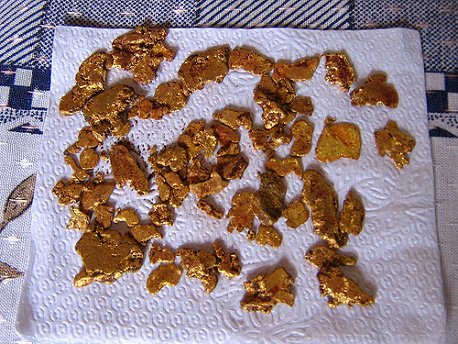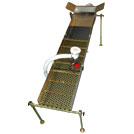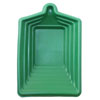Gold Nuggets. What Do They Have to do With Gold Prices Today?

Gold nuggets. We all hear about them but do you really know where they come from?
 |
Some of the gold lies in veins and a lot of it is within the solid rock. Gold may be extracted from that rock in different ways.
- First there is hard rock mining. A shaft is sunk down until the ore body is found. The rock bearing ore is taken to the surface and put through crushers until it is very fine. Then using chemicals the fine gold is extracted and sent to the refinery where it is melted down and poured into ingots.
Placer mining. Some of the gold within the veins in the rock lying just below the surface sits under streams. Over millions of years the rock containing the gold gets exposed to the effects of erosion and finds it's way into the streams and moved along the creek bed. Due to the action of the water the pieces or nuggets as they are called, work their way down through the fine gravel until they reach bedrock.
Gold prospectors have spent thousands of years attempting to find gold. The ancient Egyptians buried gold jewelry and trinkets with the bodies of their elite over 5,000 years ago.
There have been many gold rushes over the years. The Yukon gold rush back in the 1890’s produced millions of dollars worth of gold. At least 30,000 men and women left their homes to travel for in most cases, a year or more to become involved in their quest for riches. Most did not gain a penny for their efforts.
Here is what would happen when a prospector found some nuggets in the pan while working along a creek.
 |
Then he would set to work shoveling gravel and sand into the sluice allowing the gravel to run down the slope assisted by the water.
He would do this for a few hours and then stop shoveling and then he would check the burlap just in behind the riffles. That is where the gold would settle it being heavier than the rock and sand. The water would have washed most of the rest through the sluice.
 |
Finally he had his gold. If he had a promising show of gold nuggets he would now need to get to work and find the good stuff.
 |
This is the best metal detector you can use today. Click on it for details.
Gold prices today are over $1,400. per ounce. During the Yukon gold rush it was $16. The price of gold has fluctuated wildly over the years as the spot gold price moves about as if on a whim by the stock market.
This is the best metal detector you can use today. Click on it for details.
Return from Gold Nuggets to Home
Return from gold Nuggets to Gold Panning



